Abstract
1. We studied the effects of varying degrees of hypoxia for 3 min periods on the heart rate and respiration of thirty-three healthy full-term infants in a warm environment.
2. During the first 5 days of life a decrease in alveolar oxygen tension (PA, CO2) below 80 mm Hg induced hyperventilation, a decreased alveolar carbon dioxide tension (PA, CO2), and tachycardia during the first minute of hypoxia. During the second and third minute, while the decreased PA, CO2 and tachycardia persisted, ventilation fell. There was a further fall in ventilation when the baby breathed 21% O2 again. This response was also observed when the inspired gas was heated to 35° C.
3. During the first 5 days of life a decrease in PA, CO2 between 81 and 100 mm Hg did not affect ventilation or PA, CO2 during the first minute of hypoxia, but still induced a tachycardia and a fall in minute volume during the second and third minute.
4. When the PA, CO2 was elevated and maintained constant during hypoxia, ventilation increased during the first minute and fell during the second and third minutes, suggesting that hypocapnia did not explain the transient ventilatory response to hypoxia.
5. After the first week of life a greater and maintained increase in ventilation was seen during hypoxia. This response was potentiated by the addition of CO2.
6. The possibility that changes in the pulmonary circulation, associated with a functionally patent ductus arteriosus, may explain these differences, is discussed.
Full text
PDF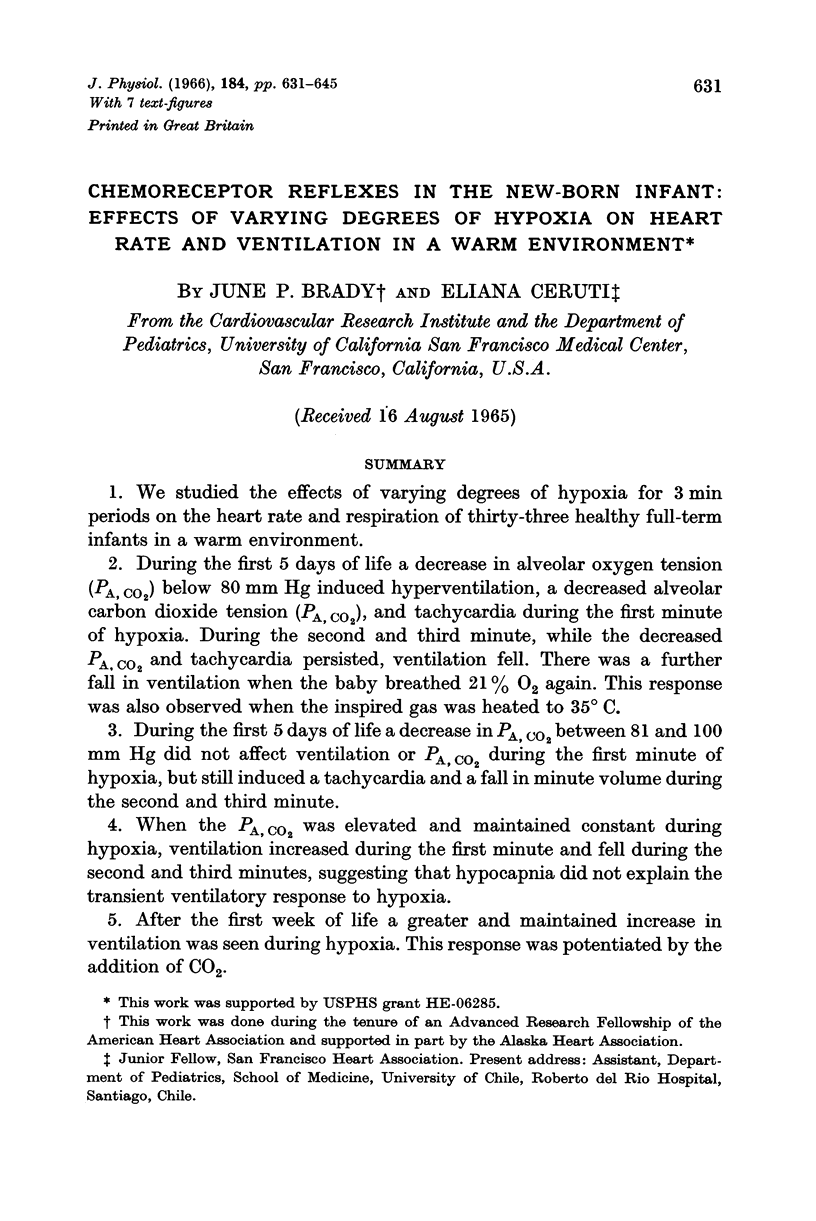
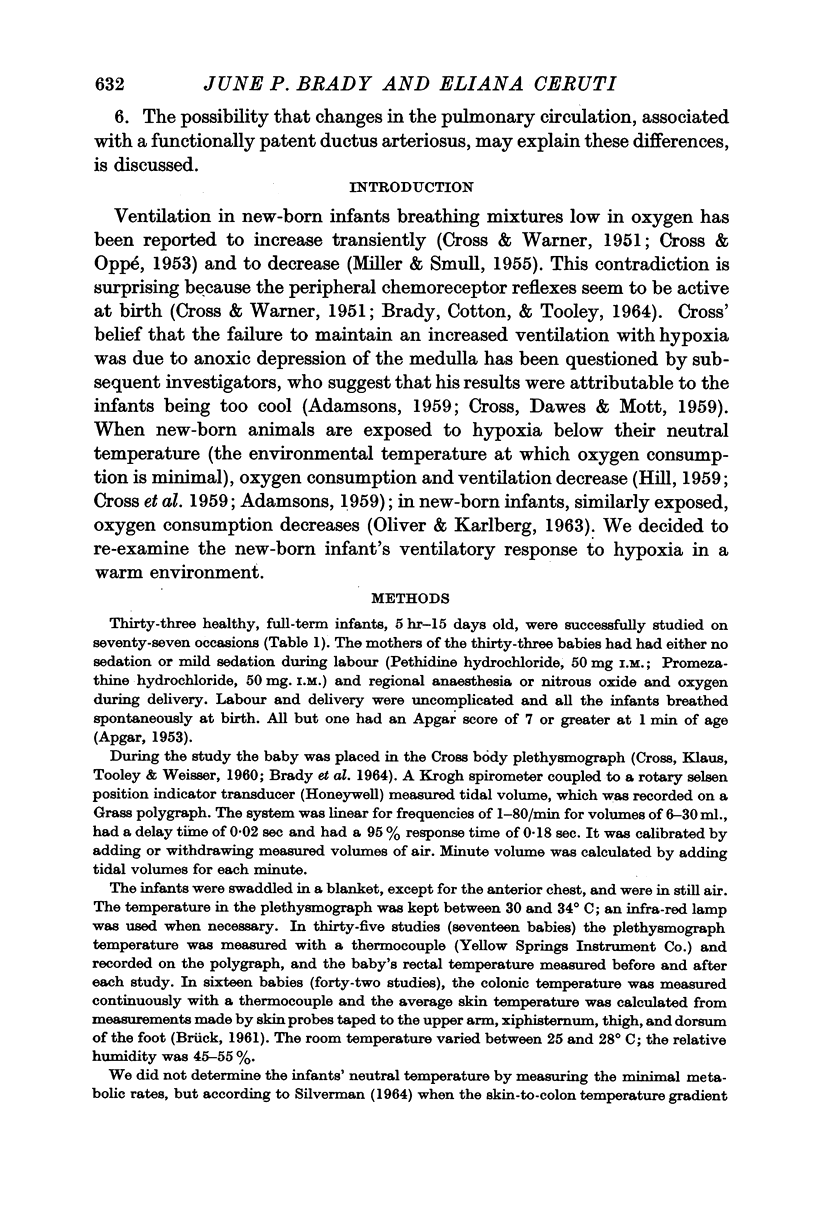
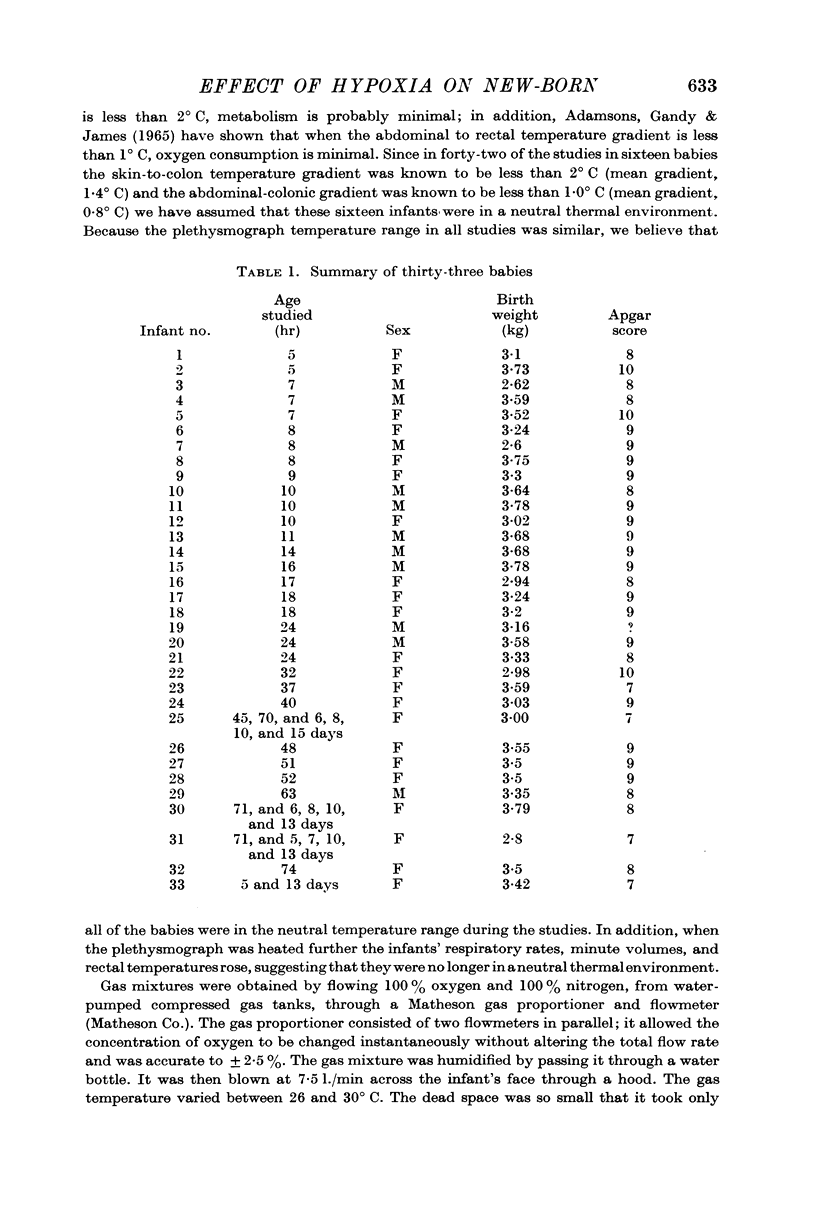
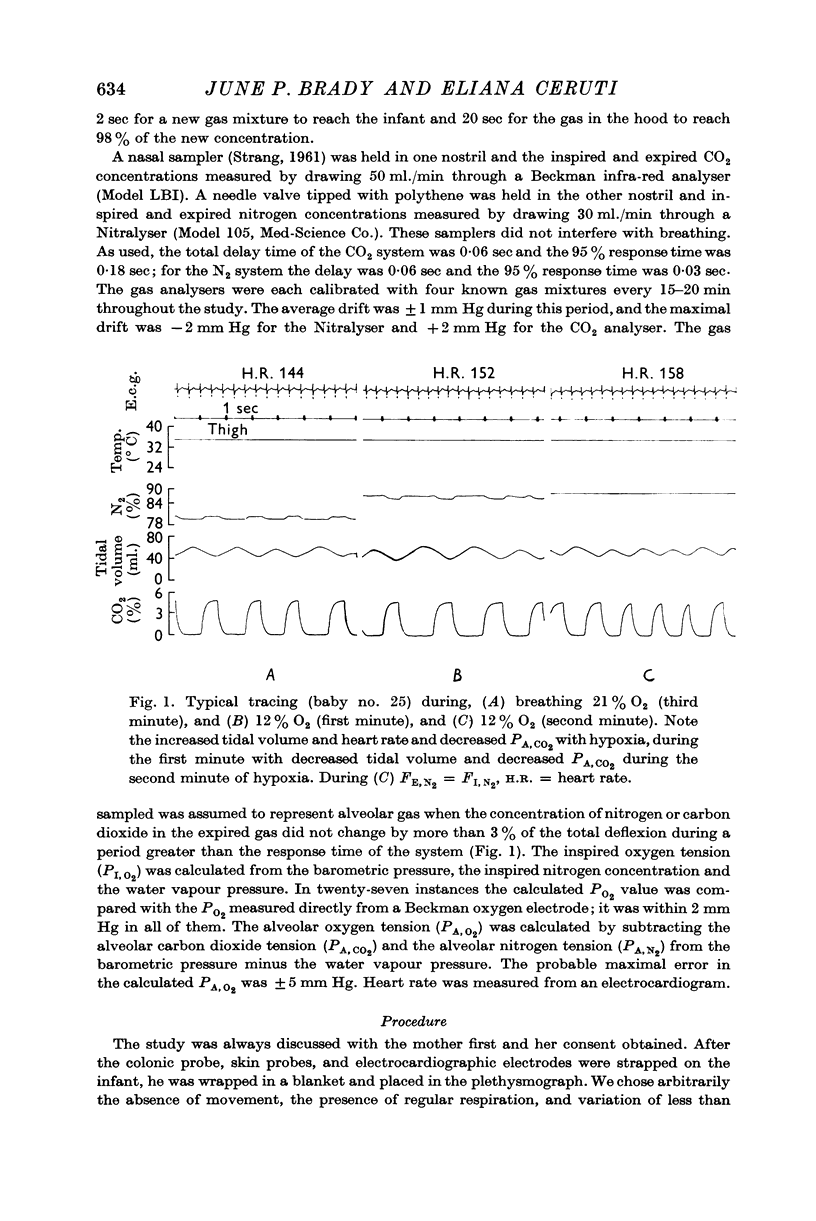
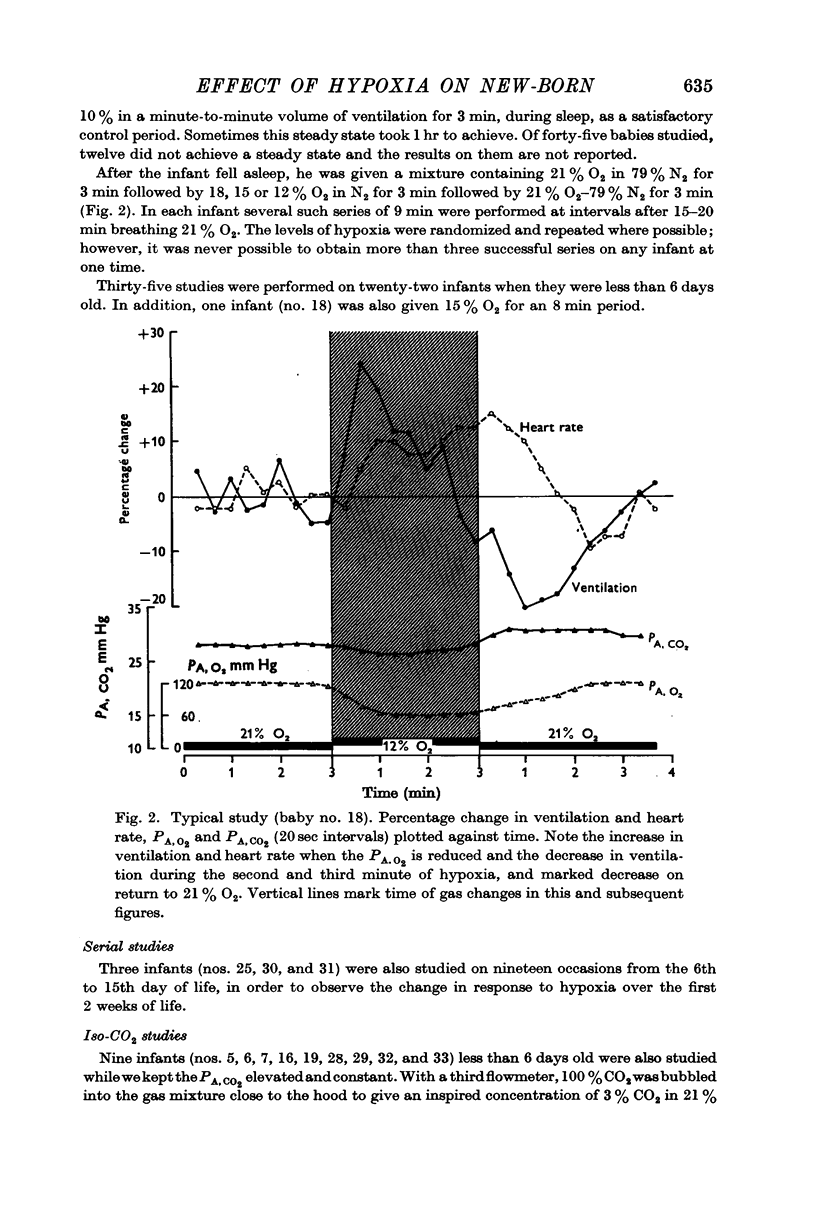
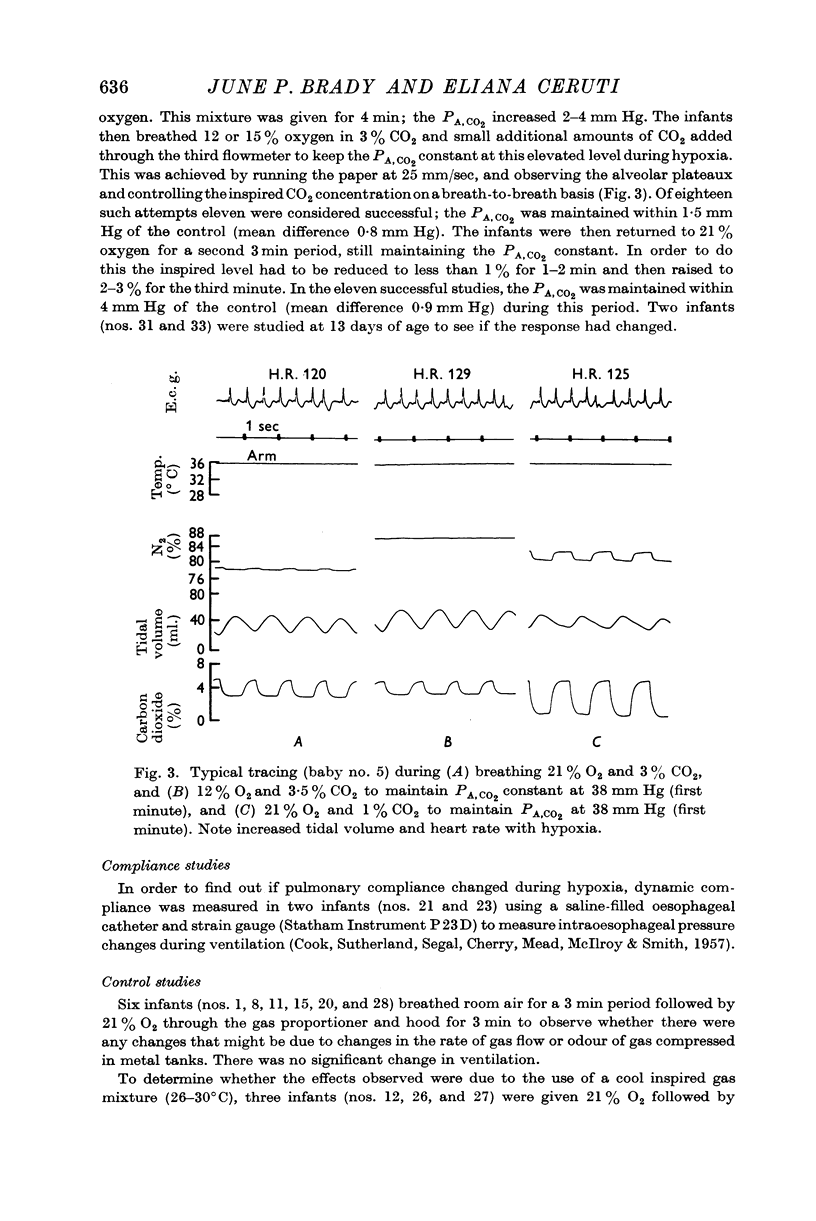
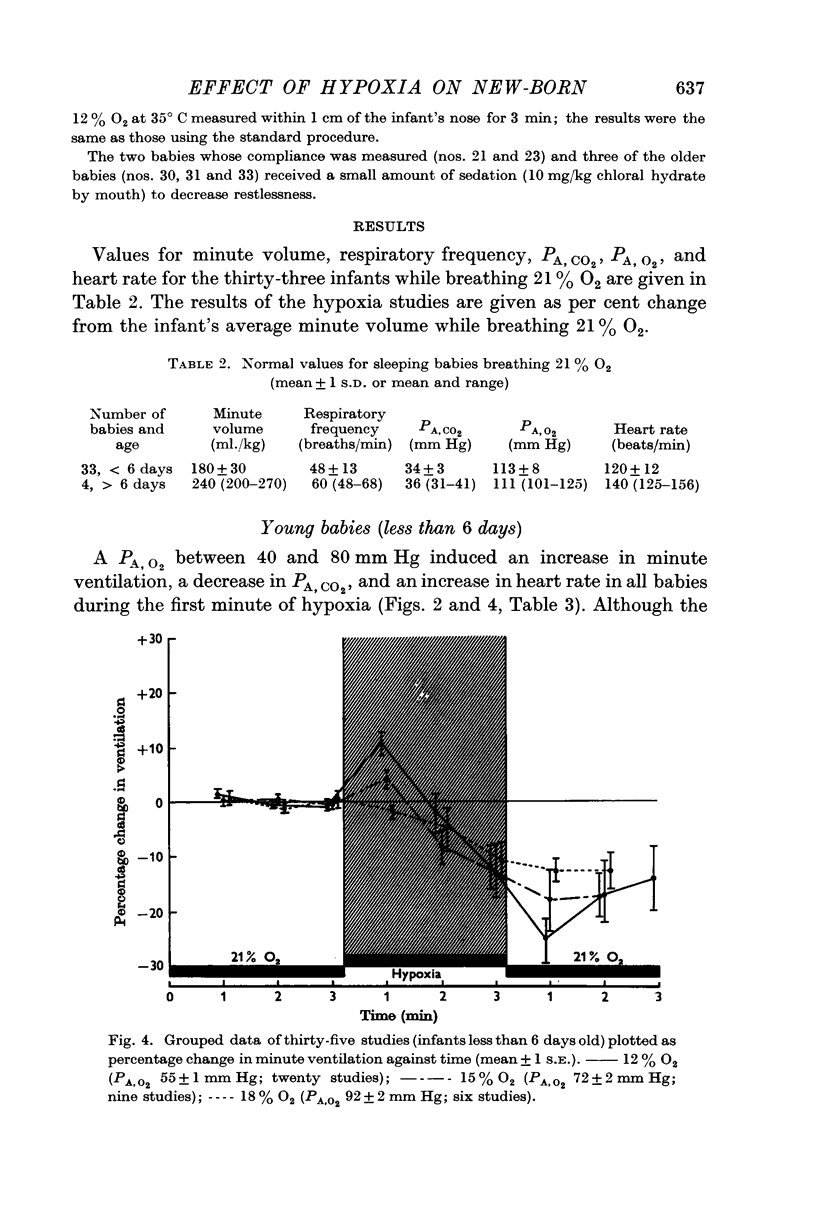
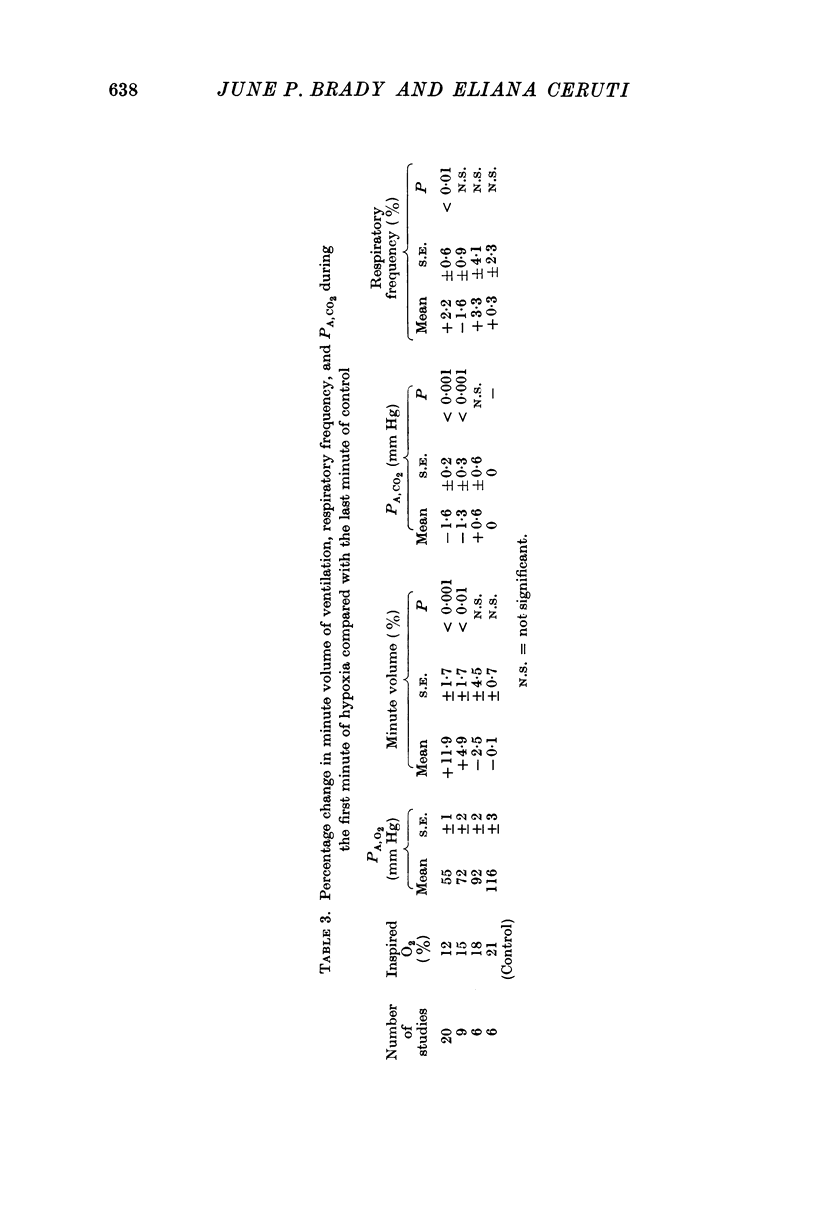
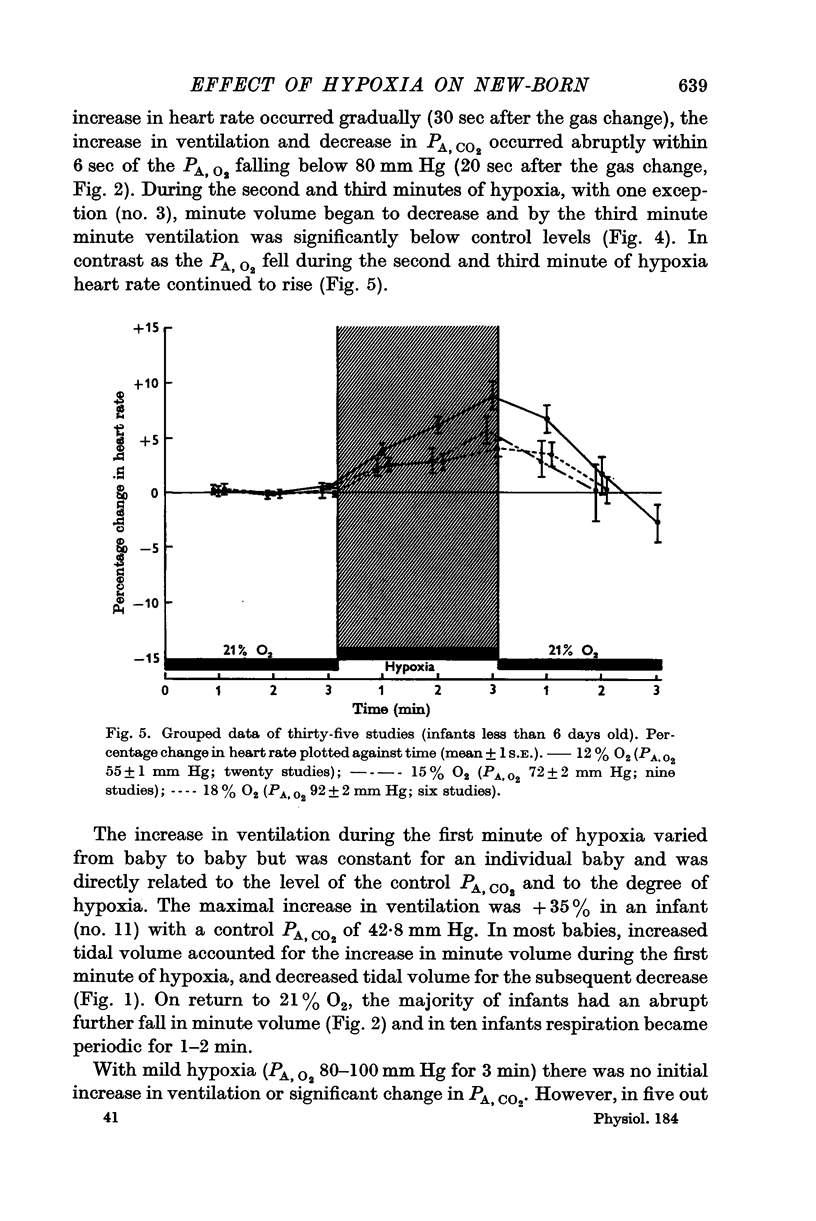
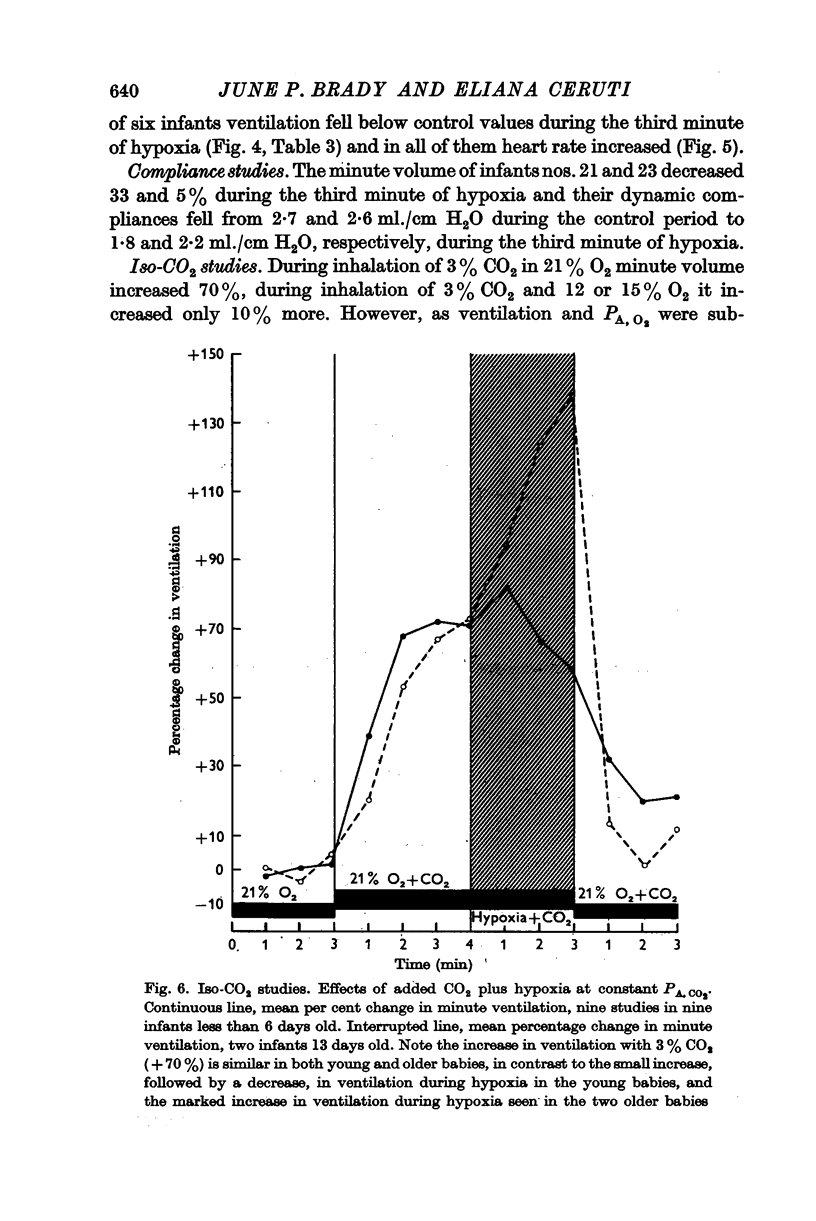
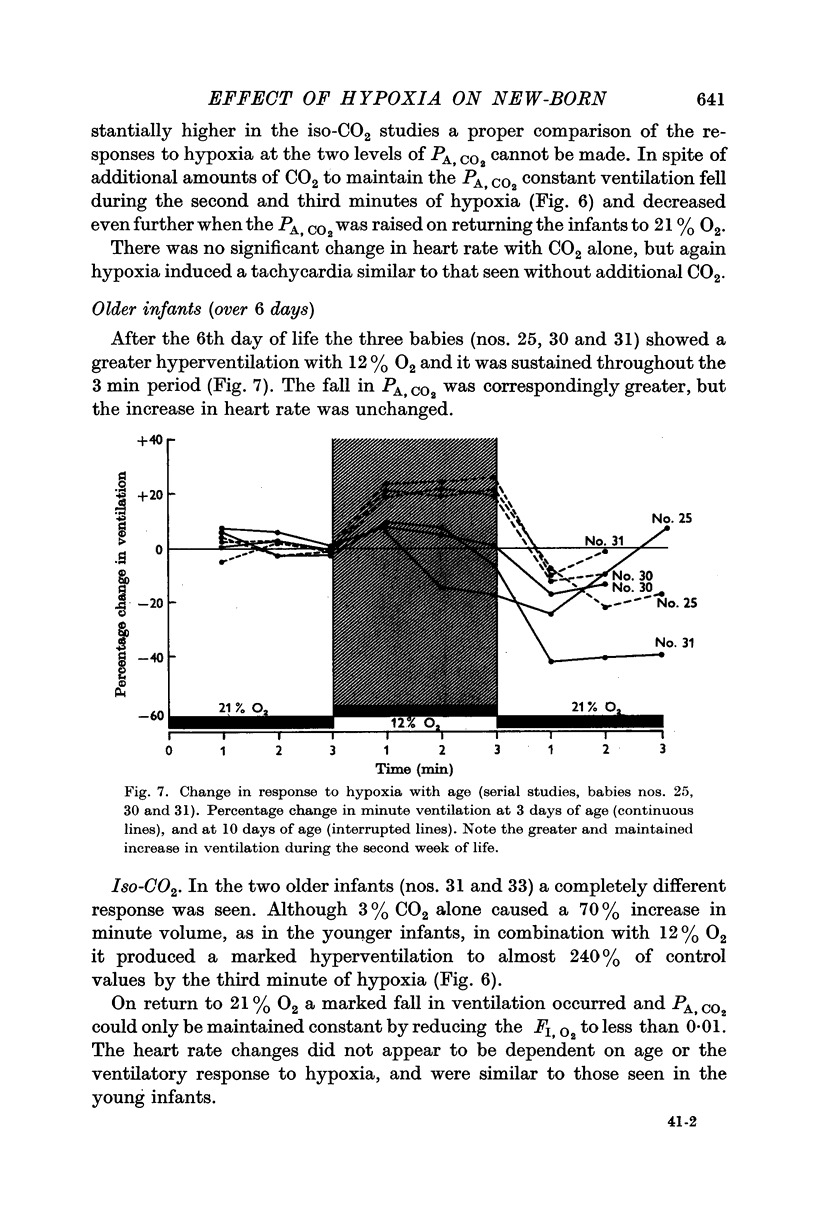
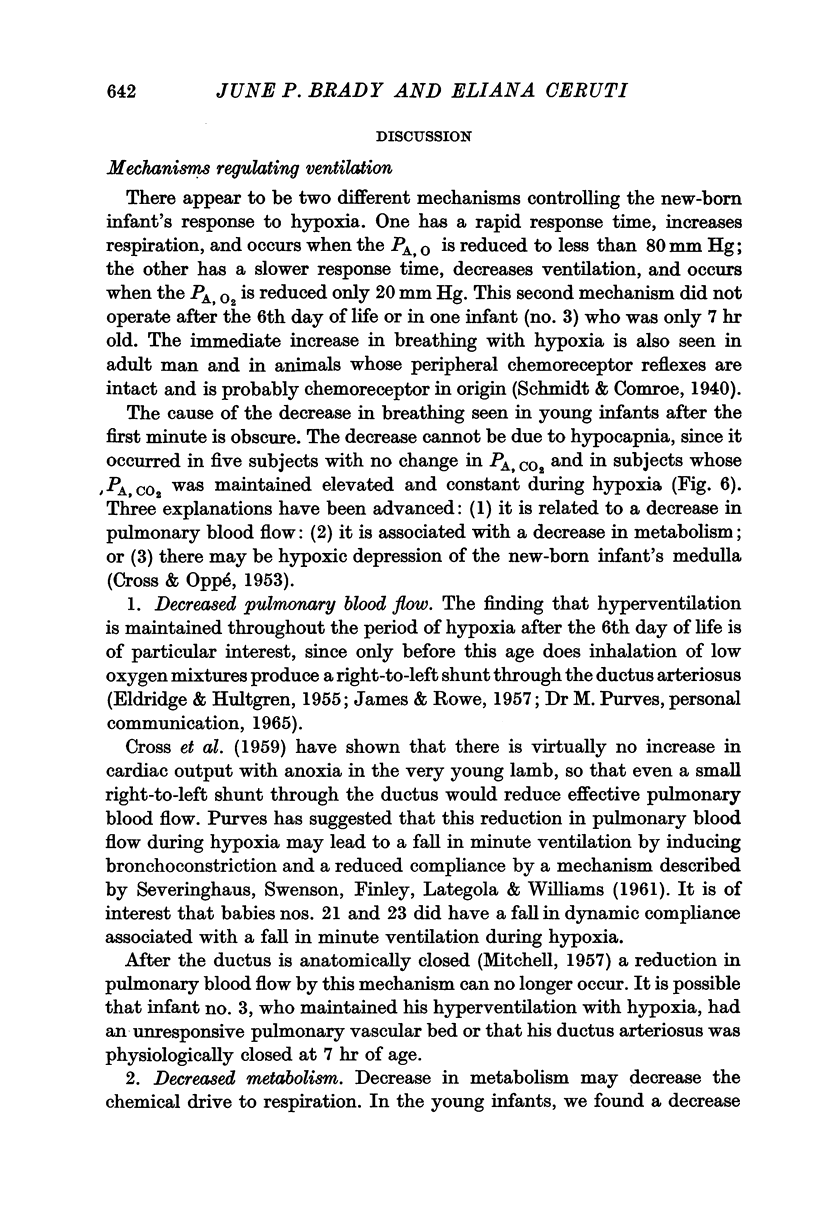
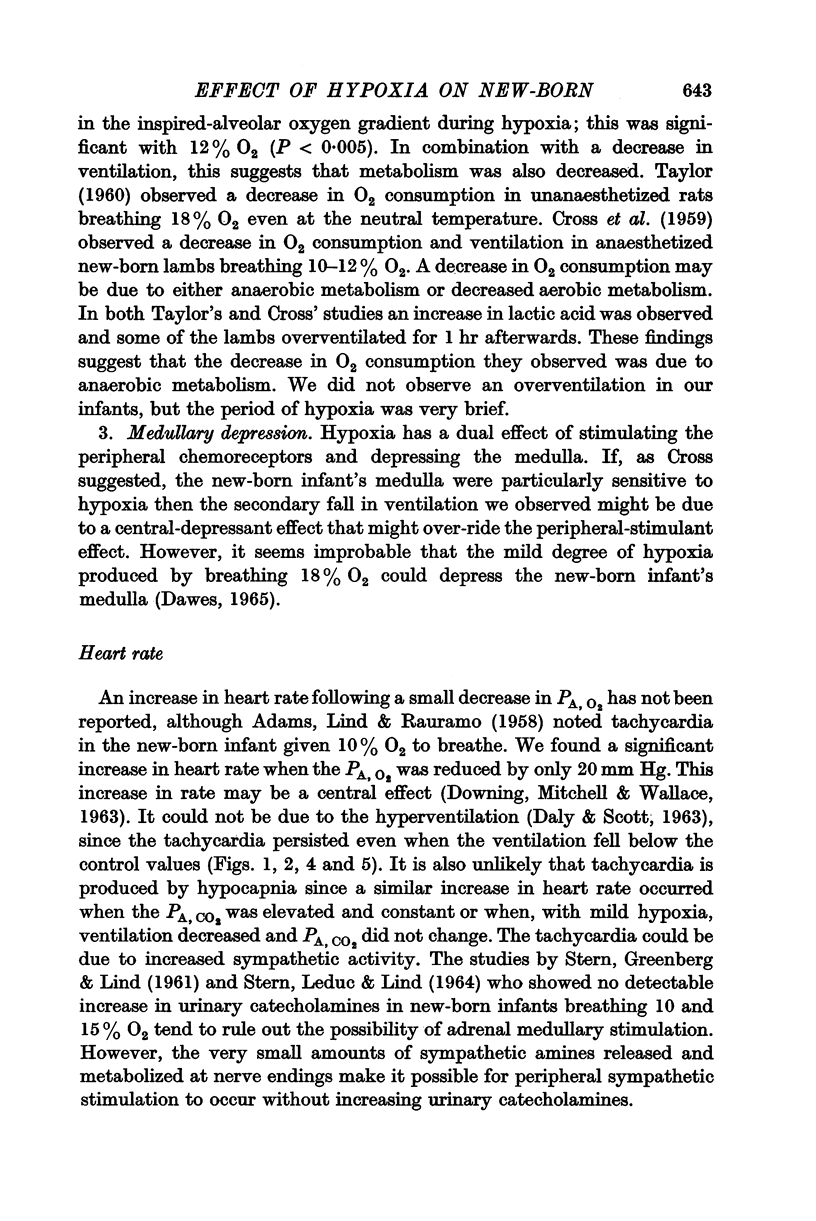
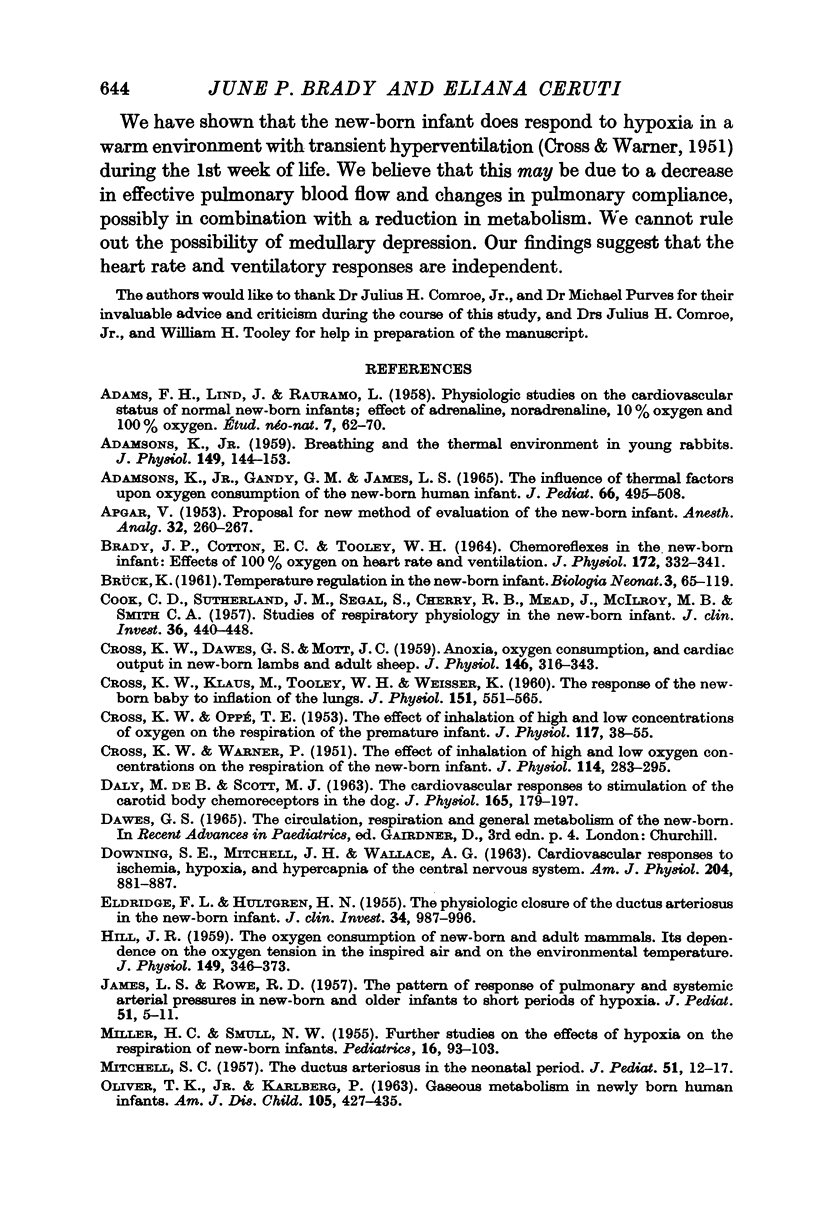

Selected References
These references are in PubMed. This may not be the complete list of references from this article.
- ADAMS F. H., LIND J., RAURAMO L. Physiologic studies on the cardiovascular status of normal newborn infants; effect of adrenaline, noradrenaline, 10% oxygen, and 100% oxygen. Etudes Neonatales. 1958 Jun;7(2):62–70. [PubMed] [Google Scholar]
- ADAMSON S. K., Jr, GANDY G. M., JAMES L. S. THE INFLUENCE OF THERMAL FACTORS UPON OXYGEN CONSUMPTION OF THE NEWBORN HUMAN INFANT. J Pediatr. 1965 Mar;66:495–508. doi: 10.1016/s0022-3476(65)80114-7. [DOI] [PubMed] [Google Scholar]
- ADAMSONS K., Jr Breathing and the thermal environment in young rabbits. J Physiol. 1959 Dec;149:144–153. doi: 10.1113/jphysiol.1959.sp006331. [DOI] [PMC free article] [PubMed] [Google Scholar]
- APGAR V. A proposal for a new method of evaluation of the newborn infant. Curr Res Anesth Analg. 1953 Jul-Aug;32(4):260–267. [PubMed] [Google Scholar]
- BRADY J. P., COTTON E. C., TOOLEY W. H. CHEMOREFLEXES IN THE NEW-BORN INFANT: EFFECTS OF 100 PER CENT OXYGEN ON HEART RATE AND VENTILATION. J Physiol. 1964 Aug;172:332–341. doi: 10.1113/jphysiol.1964.sp007421. [DOI] [PMC free article] [PubMed] [Google Scholar]
- COOK C. D., SUTHERLAND J. M., SEGAL S., CHERRY R. B., MEAD J., MCILROY M. B., SMITH C. A. Studies of respiratory physiology in the newborn infant. III. Measurements of mechanics of respiration. J Clin Invest. 1957 Mar;36(3):440–448. doi: 10.1172/JCI103441. [DOI] [PMC free article] [PubMed] [Google Scholar]
- CROSS K. W., DAWES G. S., MOTT J. C. Anoxia, oxygen consumption and cardiac output in new-born lambs and adult sheep. J Physiol. 1959 May 19;146(2):316–343. doi: 10.1113/jphysiol.1959.sp006195. [DOI] [PMC free article] [PubMed] [Google Scholar]
- CROSS K. W., KLAUS M., TOOLEY W. H., WEISSER K. The response of the new-born baby to inflation of the lungs. J Physiol. 1960 Jun;151:551–565. doi: 10.1113/jphysiol.1960.sp006459. [DOI] [PMC free article] [PubMed] [Google Scholar]
- CROSS K. W., OPPE T. E. The effect of inhalation of high and low concentrations of oxygen on the respiration of the premature infant. J Physiol. 1952 May;117(1):38–55. [PMC free article] [PubMed] [Google Scholar]
- CROSS K. W., WARNER P. The effect of inhalation of high and low oxygen concentrations on the respiration of the newborn infant. J Physiol. 1951 Jul;114(3):283–295. doi: 10.1113/jphysiol.1951.sp004620. [DOI] [PMC free article] [PubMed] [Google Scholar]
- DALY M. D., SCOTT M. J. The cardiovascular responses to stimulation of the carotid body chemoreceptors in the dog. J Physiol. 1963 Jan;165:179–197. doi: 10.1113/jphysiol.1963.sp007051. [DOI] [PMC free article] [PubMed] [Google Scholar]
- ELDRIDGE F. L., HULTGREN H. N. The physiologic closure of the ductus arteriosus in the newborn infant. J Clin Invest. 1955 Jul;34(7 Pt 1):987–996. doi: 10.1172/JCI103167. [DOI] [PMC free article] [PubMed] [Google Scholar]
- HILL J. R. The oxygen consumption of new-born and adult mammals. Its dependence on the oxygen tension in the inspired air and on the environmental temperature. J Physiol. 1959 Dec;149:346–373. doi: 10.1113/jphysiol.1959.sp006344. [DOI] [PMC free article] [PubMed] [Google Scholar]
- JAMES L. S., ROWE R. D. The pattern of response of pulmonary and systemic arterial pressures in newborn and older infants to short periods of hypoxia. J Pediatr. 1957 Jul;51(1):5–11. doi: 10.1016/s0022-3476(57)80274-1. [DOI] [PubMed] [Google Scholar]
- MILLER H. C., SMULL N. W. Further studies on the effects of hypoxia on the respiration of newborn infants. Pediatrics. 1955 Jul;16(1):93–103. [PubMed] [Google Scholar]
- MITCHELL S. C. The ductus arteriosus in the neonatal period. J Pediatr. 1957 Jul;51(1):12–17. doi: 10.1016/s0022-3476(57)80275-3. [DOI] [PubMed] [Google Scholar]
- OLIVER T. K., Jr, KARLBERG P. Gaseous metabolism in newly born human infants. The effects of environmental temperature and 15 per cent oxygen in the inspired air. Am J Dis Child. 1963 May;105:427–435. [PubMed] [Google Scholar]
- SEVERINGHAUS J. W., SWENSON E. W., FINLEY T. N., LATEGOLA M. T., WILLIAMS J. Unilateral hypoventilation produced in dogs by occluding one pulmonary artery. J Appl Physiol. 1961 Jan;16:53–60. doi: 10.1152/jappl.1961.16.1.53. [DOI] [PubMed] [Google Scholar]
- SILVERMAN W. A. DIAGNOSIS AND TREATMENT: USE AND MISUSE OF TEMPERATURE AND HUMIDITY IN CARE OF THE NEWBORN INFANT. Pediatrics. 1964 Feb;33:276–277. [PubMed] [Google Scholar]
- STERN L., LEDUC J., LIND J. HYPOXIA AS A STIMULUS TO CATECHOLAMINE EXCRETION IN THE NEWBORN INFANT. II. THE EFFECT OF EXPOSURE TO 10 PER CENT O2. Acta Paediatr. 1964 Jan;53:13–17. doi: 10.1111/j.1651-2227.1964.tb07201.x. [DOI] [PubMed] [Google Scholar]
- TAYLOR P. M. Oxygen consumption in new-born rats. J Physiol. 1960 Nov;154:153–168. doi: 10.1113/jphysiol.1960.sp006570. [DOI] [PMC free article] [PubMed] [Google Scholar]


